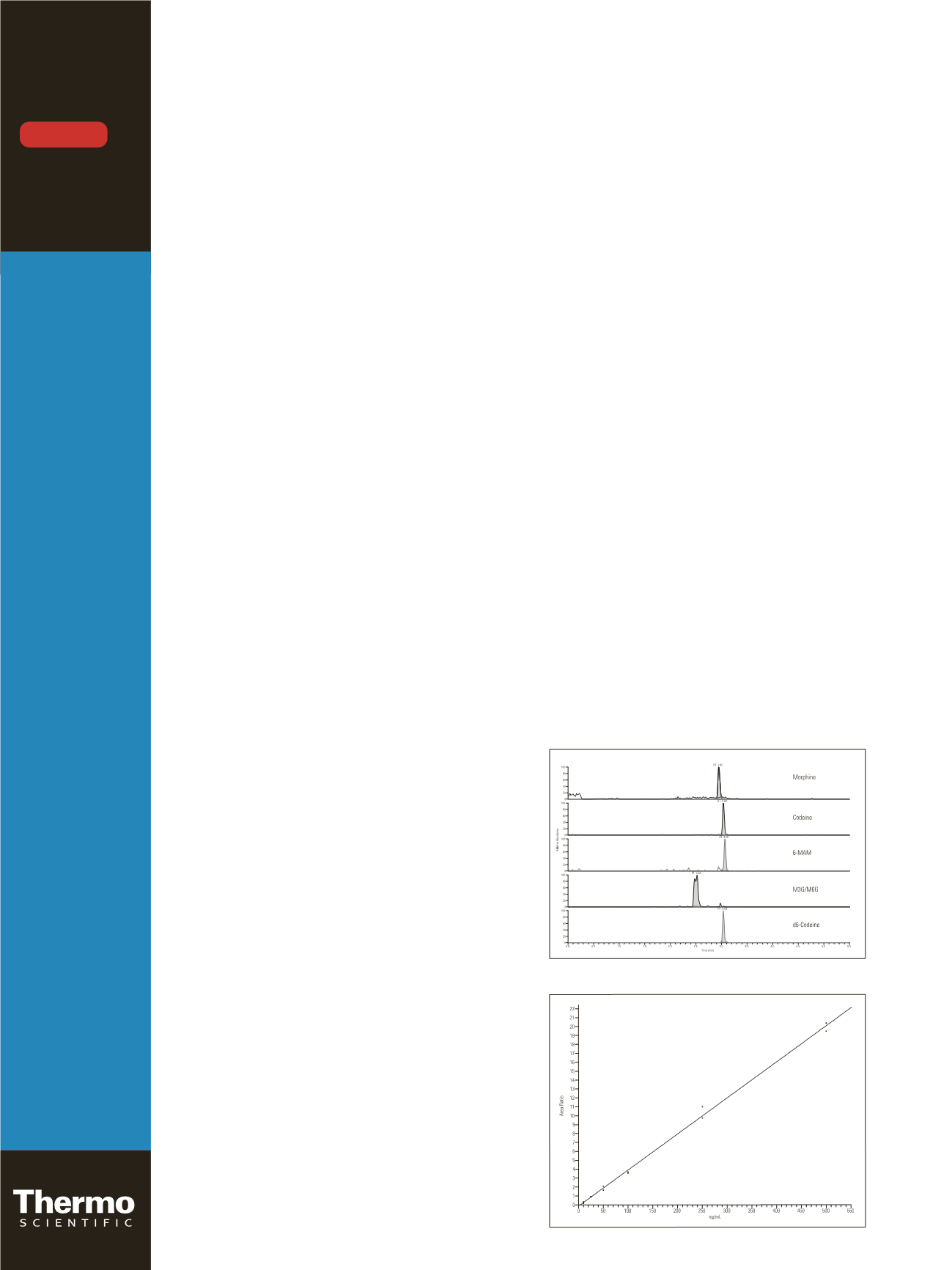

Forensic Analysis of Opiates in Whole Blood
by LC-MS/MS Using Automated, Online
Sample Preparation
Peter Ashton, Alex Allan, Bob Ardrey, Triple A Forensics Ltd., Oldham, UK
Shane McDonnell, Sarah Robinson, Thermo Fisher Scientific, Hemel Hempstead, UK
Introduction
Forensic use of free- and protein-bound opiate analytes in
whole blood by LC-MS/MS traditionally requires rigorous
sample cleanup via solid phase extraction (SPE) or liquid-
liquid extraction (LLE). The method described here can be
used in place of these laborious offline sample preparation
methods.
Goal
The goal is to quantitate opiate compounds in whole
blood by using a simple, fast, low-volume protein
precipitation step followed by a Thermo Scientific
TurboFlow method coupling automated, online sample
preparation and chromatography with selective reaction
monitoring (SRM) tandem mass spectrometry.
Experimental
Sample Preparation
Horse blood was spiked with a mixture of opiates
[codeine, morphine, 6-monoacetyl morphine (6-MAM),
morphine-3-glucuronide (M3G), morphine-6-glucuronide
(M6G), and d6-codeine (internal standard)] at
concentrations ranging from 1 ng/mL to 500 ng/mL. A
150 µL sample of spiked whole blood was mixed with
200 µL acetonitrile, vortexed, and centrifuged for 10
minutes at 300 rpm. For analysis, 10 µL of supernatant
was used.
HPLC
HPLC analysis was performed using the Thermo Scientific
Transcend TLX-1 system. Whole blood supernatant
samples were extracted using a TurboFlow™ Cyclone
MAX column (0.5 x 50 mm). Chromatographic
separation was performed using a Thermo Scientific
Hypersil GOLD aQ column (50 x 2.1 mm, 5 µm).
Mass Spectrometry
MS analysis was carried out on a Thermo Scientific TSQ
Quantum Ultra triple stage quadrupole mass spectrometer
with a heated electrospray ionization (H-ESI) source. The
SRM mode was used for mass spectrometry detection.
Results and Discussion
The extracted ion chromatograms of the lowest
concentration sample are presented in Figure 1. The
calibration curves for morphine (Figure 2), codeine and
M3G/M6G covered 10–500 ng/mL and the curve for the
6-MAM metabolite covered 1–50 ng/mL. All calibration
curves were linear over the concentration range, and
carryover was calculated at less than 1% for all analytes.
Conclusion
The use of a simple, rapid work-up followed by a
TurboFlow method on the Transcend™ TLX-1 system
followed by MS/MS analysis allowed the specific and
sensitive analysis of various common opiates and their
metabolites from a small volume of whole blood. The
4 minute method allows 15 samples per hour to be
completed, and the throughput can be doubled or
quadrupled with the use of multiplexing. Significant time
is saved with the absence of SPE or LLE sample
preparation.
The forensic toxicologist can use this method to assist
with the determination of time of heroin injection
(presence of 6-MAM) and the detection of M3G and
M6G to determine prior use or accumulation following
heavy use of opiates.
Assay performance summary
Target Analytes
codeine, morphine, 6-MAM, M3G,
M6G
Matrix
whole blood
Assay Linearity
1 - 50 ng/mL (6-MAM)
10 - 500 ng/mL (all other analytes))
Carryover at LLOQ < 1% for all analytes
Sample Volume
10 µL
Analysis Time
~ 4 minutes
Key Words
• Transcend TLX-1
• TurboFlow
Technology
• TSQ Quantum
Ultra
• Forensic
Toxicology
Application
Note: 461b
Figure 1: Extracted ion chromatogram for the lowest standard of each analyte
Figure 2: Calibration curve for the analyte morphine from 10–500 ng/mL
DOWNLOAD


















